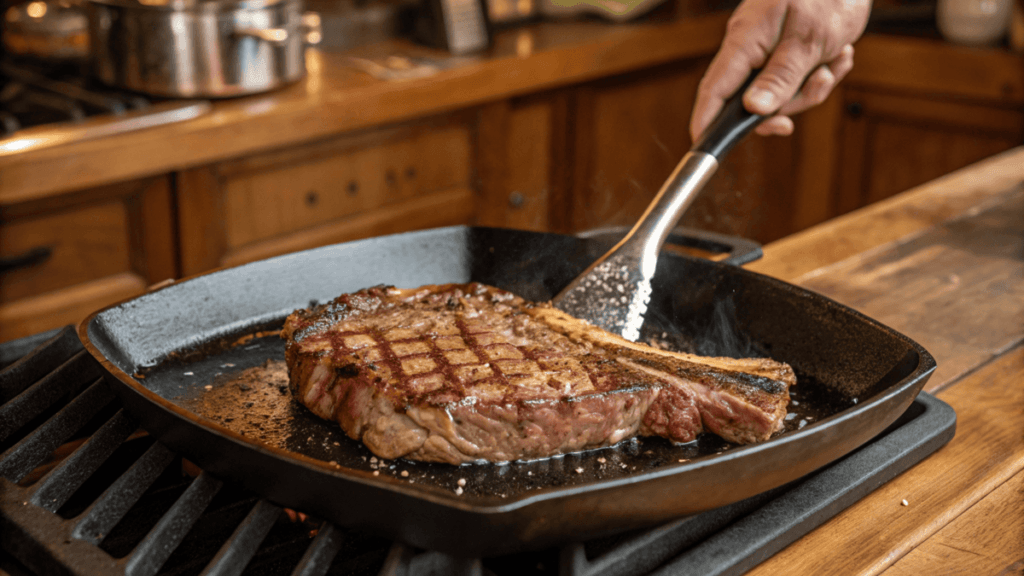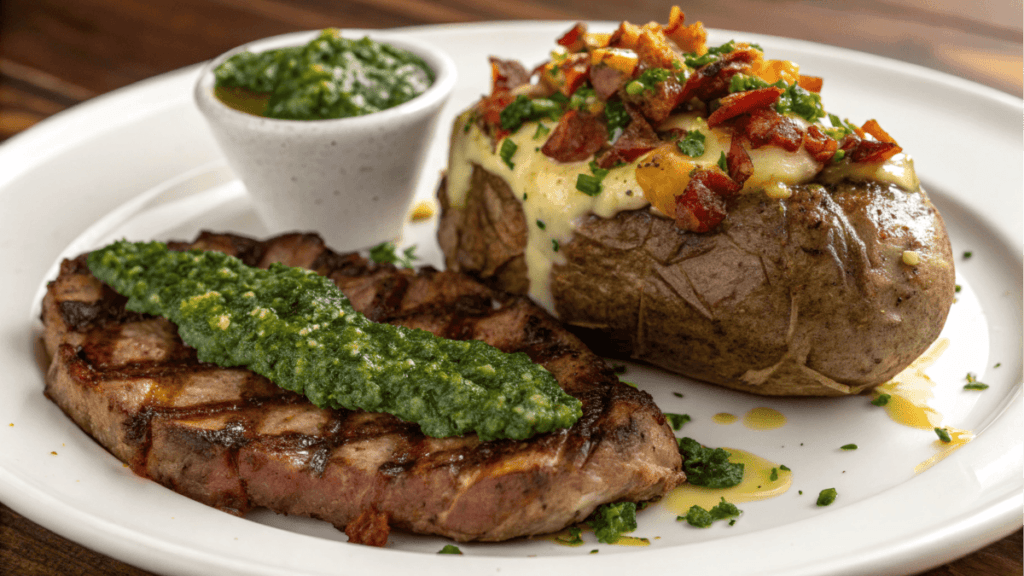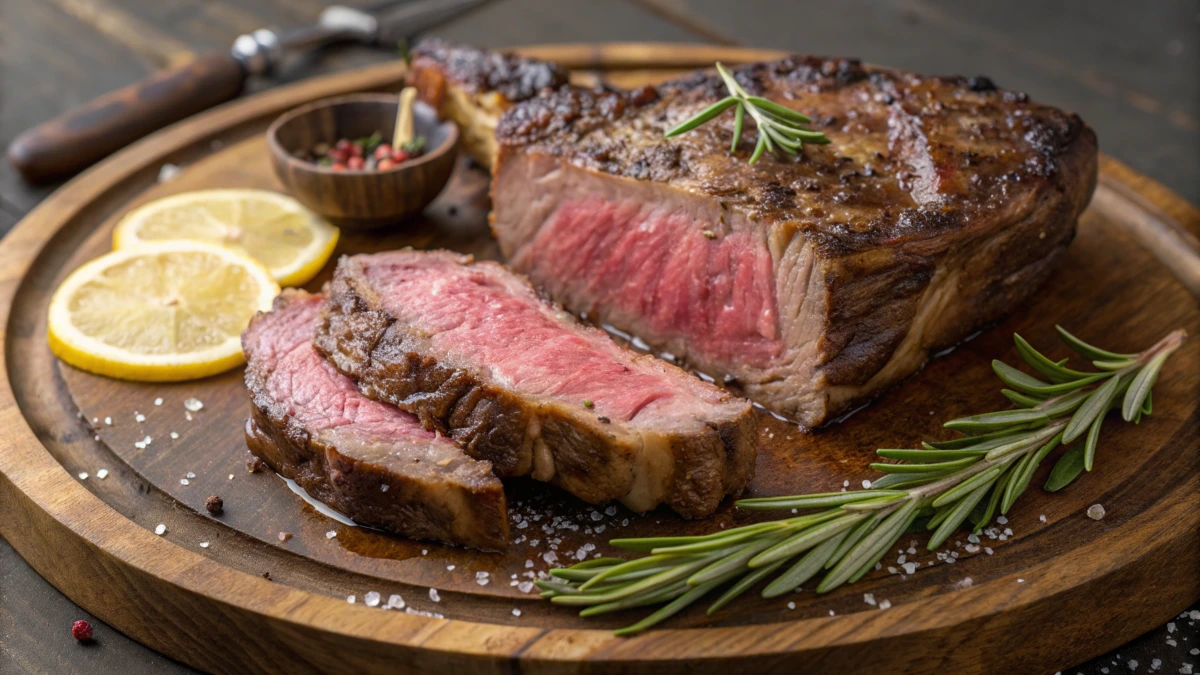Cowboy steak—just the name conjures up images of bold flavors, sizzling meat, and hearty meals. Known for its distinct bone-in structure and rich marbling, this steak cut has become a favorite for steak lovers worldwide. In this guide, you’ll discover everything from what makes a cowboy steak unique to how you can cook it to perfection. We’ll delve into selection tips, seasoning secrets, and even creative uses for leftovers. So grab your apron and cast iron skillet, and let’s dive into the world of cowboy steak.
What is a Cowboy Steak?
Introduction to Cowboy Steak
A cowboy steak is more than just a meal—it’s an experience. This thick, bone-in cut comes from the rib primal, offering a robust flavor that sets it apart from your standard ribeye. What makes it even more irresistible is its dramatic presentation, with a single exposed rib bone lending it a rustic, adventurous vibe. It’s the perfect steak for grilling enthusiasts or anyone looking to impress at their next dinner party.
Cowboy Steak vs. Ribeye and Tomahawk
While a ribeye steak and cowboy steak both hail from the same primal cut, their differences lie in size and presentation. A cowboy steak is larger, heartier, and comes with a shorter bone, while the tomahawk steak features a longer, more dramatic bone—ideal for Instagram-worthy pictures. Flavor-wise, all three cuts share the rib primal’s rich, buttery taste, but the cowboy steak’s bone-in nature adds an extra layer of depth thanks to the marrow.
Why the Name “Cowboy Steak”?
The term “cowboy steak” evokes the rugged lifestyle of the American West. Legend has it that cowboys preferred this cut because the bone acted as a handle, making it easy to cook over an open flame and eat right off the grill. Whether that’s true or not, this steak’s hearty texture and bold flavor certainly make it deserving of its adventurous name.
Selecting the Perfect Cowboy Steak
Understanding the Cut
Choosing the right cowboy steak starts with knowing its unique characteristics. This cut comes from the rib primal, nestled above the rib cage. It’s renowned for its tender texture, generous marbling, and bold, beefy flavor. The thick bone not only makes it visually striking but also enhances the flavor by infusing the meat with rich marrow during cooking. If you’re aiming for an indulgent steak experience, this is the cut to pick.
What to Look for When Buying
When shopping for a cowboy steak, focus on quality and appearance. Opt for a steak with even marbling, as these streaks of fat melt during cooking, giving the meat its signature juiciness. Look for a bone that’s well-trimmed but still adds to the steak’s rustic charm. Ensure the meat is bright red with no dull or grayish tones—this signals freshness. And don’t hesitate to ask your butcher for advice; they’re often happy to guide you toward the perfect cut.
Fresh vs. Frozen Steaks
While fresh cowboy steaks are ideal for maximum flavor and texture, frozen ones can work well too if handled properly. Always thaw frozen steaks in the fridge overnight to maintain their natural juices. While some may argue fresh is best, a well-thawed and properly cooked frozen cowboy steak can be just as satisfying.
With these tips in mind, you’re ready to transform a simple cut of meat into a show-stopping meal. Up next: the perfect seasonings and sides to complement your cowboy steak.
How to cook a Cowboy SteaK
Pan-Seared Cowboy Steak
Pan-searing is a foolproof way to prepare a cowboy steak, giving it a caramelized crust that locks in flavor. Begin by patting the steak dry and seasoning it generously with salt and pepper. Heat a cast iron skillet until it’s smoking hot, then add oil for a high-temperature sear. Sear each side for 3-4 minutes until golden brown, then finish in the oven for even cooking. Don’t forget to baste the steak with melted butter infused with herbs like rosemary or thyme—it’s the secret to restaurant-quality flavor.

Grilling Methods for Smoky Flavor
Grilling is a classic choice for cooking cowboy steaks, imparting a smoky aroma and charred exterior. Start by preheating the grill to high heat. Place the steak over direct heat for a few minutes on each side to achieve those coveted grill marks. Then, move it to indirect heat and cover the grill, allowing the steak to cook slowly to your desired doneness. For an added flavor boost, throw some wood chips on the coals for a hint of smokiness.
Oven-Finishing for Consistency
For steak lovers who want precision, oven-finishing is a reliable method. After pan-searing or grilling the steak, transfer it to a preheated oven at 400°F. Use a meat thermometer to monitor the internal temperature, removing the steak about 5°F below your target doneness to account for carryover cooking. This method ensures every bite of your cowboy steak is tender and juicy.
Using Meat Thermometers
To nail the perfect doneness, a meat thermometer is your best friend. For medium-rare, aim for 130°F, while medium should hit around 135°F. Insert the thermometer into the thickest part of the steak for an accurate reading. This small step can make a big difference in achieving a steak that’s cooked just the way you like it.
With these tips in mind, you’re ready to transform a simple cut of meat into a show-stopping meal. Up next: the perfect seasonings and sides to complement your cowboy steak.
Essential Seasonings and Accompaniments
Basic Seasoning Combinations
Kosher Salt: Enhances flavor and creates a flavorful crust.
Freshly Cracked Black Pepper: Adds subtle heat and depth of flavor.
Garlic Powder: Provides a mild, savory flavor to complement the steak.
Smoked Paprika (Optional): Adds smoky sweetness and rich color.
Crushed Red Pepper Flakes (Optional): Brings a touch of heat to balance the richness.
These simple ingredients will elevate the natural flavors of the steak while keeping the seasoning straightforward and clear.
Complementary Sauces and Sides
The right accompaniments can take your cowboy steak to the next level. Classic pairings like garlic butter or chimichurri sauce work wonders by adding layers of flavor. For sides, consider mashed potatoes, grilled asparagus, or a fresh arugula salad to balance the steak’s richness. Looking for something indulgent? Creamed spinach or truffle mac and cheese make for a luxurious meal.
Marinades for Extra Tenderness
For an added flavor boost, marinate your cowboy steak for a few hours before cooking. A blend of olive oil, balsamic vinegar, soy sauce, and fresh herbs like rosemary and thyme creates a savory marinade that tenderizes the meat while adding depth. Keep marinades simple to ensure they complement, not overpower, the steak’s natural taste.
Cowboy Steak Storage and Reheating
Proper Storage Techniques
Leftovers from a perfectly cooked cowboy steak should never go to waste. Store them properly by wrapping the steak tightly in aluminum foil or placing it in an airtight container. Refrigerate it within two hours of cooking to preserve its freshness. Properly stored, the steak can last in the fridge for up to three days.
Reheating Methods
Reheating a cowboy steak without drying it out requires a gentle touch. The best method is to use the oven. Place the steak on a wire rack over a baking sheet and reheat it at 275°F until the internal temperature reaches 130°F. Alternatively, you can reheat it in a skillet with a touch of butter to revive its flavors and texture.
Creative Ways to Use Leftovers
Got leftover cowboy steak? Turn it into a gourmet delight! Slice it thin and toss it into a salad with a tangy vinaigrette. Or use it to create a hearty steak sandwich with caramelized onions and melted cheese. For breakfast, try pairing the slices with sunny-side-up eggs for a steak-and-eggs combo that starts your day off right.
For more delicious recipes, check out this mouthwatering collection of meals, where you’ll find ideas to complement your steak or inspire your next culinary creation.
Frequently Asked Questions
What’s the difference between a cowboy steak and a tomahawk?
Many people wonder what sets a cowboy steak apart from a tomahawk steak. While both come from the rib primal, the primary difference lies in the bone length. A tomahawk steak has an elongated bone, resembling a handle, which gives it a dramatic appearance. In contrast, the cowboy steak has a shorter bone, making it slightly more practical for cooking and serving. Despite their visual differences, both cuts deliver exceptional flavor and tenderness.
Best Cooking Methods for Beginners
If you’re new to cooking steak, preparing a cowboy steak can seem intimidating, but it doesn’t have to be. The pan-searing method is a beginner-friendly approach that guarantees a golden crust and juicy interior. Simply season the steak, sear it in a hot skillet, and finish it in the oven. If you prefer grilling, keep a close eye on the steak’s temperature and use indirect heat to prevent overcooking.
Why Resting the Steak Matters
Resting your cowboy steak after cooking is a crucial step that often gets overlooked. By letting the steak sit for 5-10 minutes, the juices redistribute throughout the meat, resulting in every bite being tender and flavorful. Cutting into a steak too soon can cause those delicious juices to spill out, leaving the meat dry.
What is the most tender steak?
The most tender steak is widely considered to be the filet mignon, cut from the tenderloin of the cow. This particular cut stands out because it comes from a muscle that does very little work, resulting in its incredibly soft texture. Furthermore, filet mignon is prized for its mild flavor and fine-grained consistency, making it a favorite for those who enjoy a luxurious dining experience. While it is not as richly marbled as ribeye or strip steak, its tenderness more than compensates. Therefore, for those seeking a melt-in-your-mouth steak, filet mignon is the ultimate choice.
Additional Tips and Recipes
Expert Tips for Perfect Cowboy Steak
Getting the perfect cowboy steak involves more than just cooking. Start by bringing the steak to room temperature before cooking to ensure even doneness. Use a meat thermometer to avoid overcooking, and always slice against the grain for the most tender bites. For extra flavor, try finishing your steak with a sprinkle of flaky sea salt right before serving.
Popular Recipes to Try
Ready to explore more ways to enjoy your cowboy steak? Try pairing it with chimichurri sauce or topping it with garlic herb butter for an easy upgrade. For a complete meal, serve it alongside roasted vegetables or a loaded baked potato. If you’re feeling adventurous, experiment with dry rubs featuring smoked paprika, brown sugar, and a touch of cayenne for a barbecue-inspired twist.

Room Temperature vs. Cold Steaks
Starting with a room-temperature cowboy steak can make a big difference in cooking results. Cold steaks take longer to cook, often leading to uneven doneness. Letting the steak sit out for 30 minutes before cooking helps it cook evenly and achieves that perfect medium-rare or medium center. It’s a small step that yields big results.
With these tips and recipes, you’re well on your way to mastering the art of cooking a cowboy steak. From selecting the right cut to nailing the cooking techniques, this guide has you covered. Let’s finish up with a quick FAQ section to address common queries!
FAQs Section Based on “People Also Ask”
How Long Should You Cook a Cowboy Steak?
The cooking time for a cowboy steak depends on its thickness and your preferred doneness. For medium-rare, aim for about 4-5 minutes per side on high heat, followed by 10-15 minutes in the oven at 400°F. Use a meat thermometer to check the internal temperature—130°F for medium-rare or 135°F for medium. Remember, letting the steak rest after cooking helps the juices settle, enhancing every bite.
How many people will a cowboy steak feed?
A cowboy steak is a large, bone-in ribeye that typically weighs around 2 to 2.5 pounds. Generally, it can serve two to three people, depending on appetite and portion size. Moreover, when paired with hearty side dishes, it can easily satisfy a small group. Therefore, it’s a great choice for sharing at gatherings or special occasions.
What does “cowboy cut” mean?
The term “cowboy cut” refers to a style of clothing, particularly jeans, designed with functionality and durability in mind for cowboys and ranch workers. Typically, these jeans feature a slim fit through the hips and thighs, straight legs, and a higher rise to accommodate boots comfortably. Moreover, they are often reinforced with sturdy stitching to endure tough conditions. Additionally, the design prioritizes practicality, making them ideal for horseback riding and physical labor. As a result, “cowboy cut” has become synonymous with rugged, western-inspired fashion that blends utility and style seamlessly.
What is the best cut of steak?
The best cut of steak often depends on personal preference, but many consider the ribeye to be a top choice for its rich marbling and flavor. Additionally, the filet mignon is prized for its tenderness, offering a melt-in-your-mouth experience. On the other hand, the New York strip provides a balance of tenderness and beefy flavor, making it a favorite for steak enthusiasts. Furthermore, the T-bone or porterhouse combines the best of both worlds, featuring both a tender filet and a flavorful strip. Ultimately, the best cut comes down to individual taste, whether you prioritize flavor, tenderness, or a combination of both.

